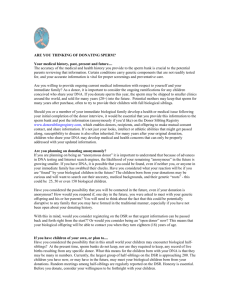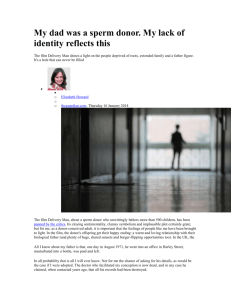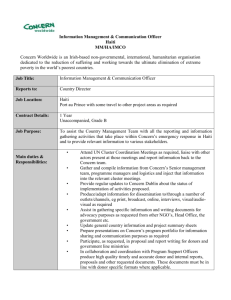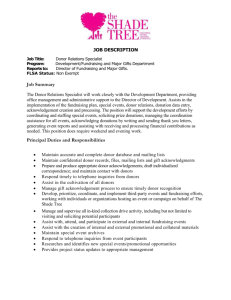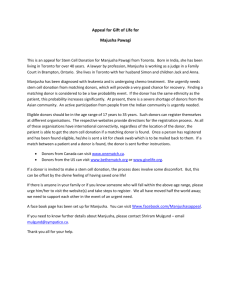Wendy`s handout. - Donor Sibling Registry
advertisement
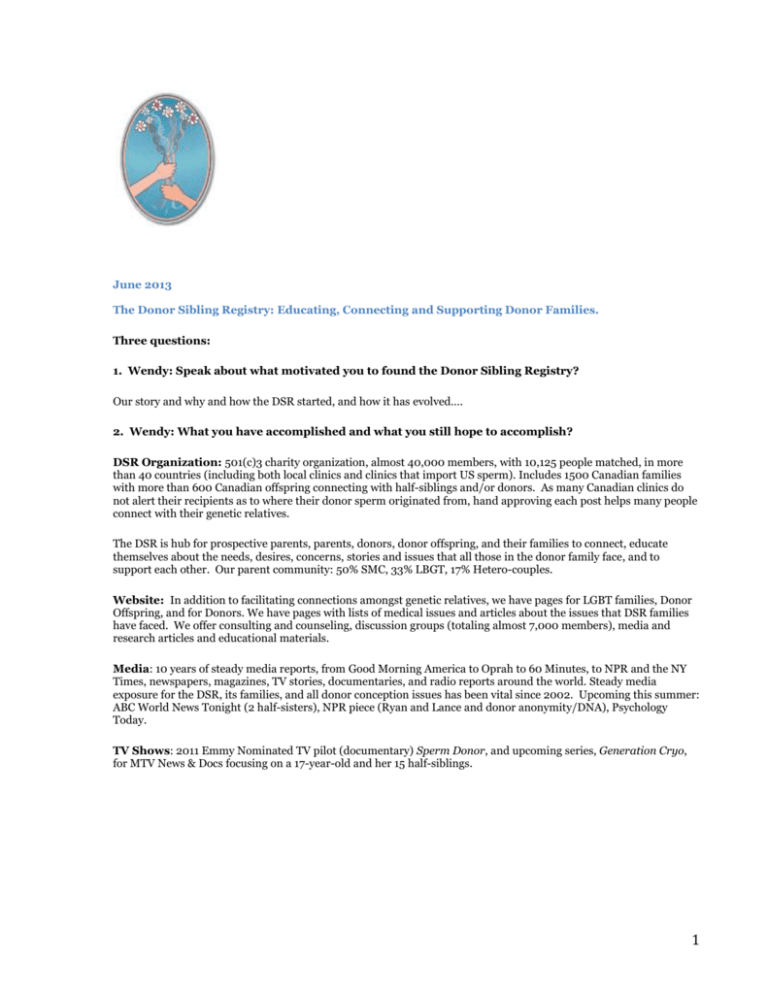
June 2013 The Donor Sibling Registry: Educating, Connecting and Supporting Donor Families. Three questions: 1. Wendy: Speak about what motivated you to found the Donor Sibling Registry? Our story and why and how the DSR started, and how it has evolved…. 2. Wendy: What you have accomplished and what you still hope to accomplish? DSR Organization: 501(c)3 charity organization, almost 40,000 members, with 10,125 people matched, in more than 40 countries (including both local clinics and clinics that import US sperm). Includes 1500 Canadian families with more than 600 Canadian offspring connecting with half-siblings and/or donors. As many Canadian clinics do not alert their recipients as to where their donor sperm originated from, hand approving each post helps many people connect with their genetic relatives. The DSR is hub for prospective parents, parents, donors, donor offspring, and their families to connect, educate themselves about the needs, desires, concerns, stories and issues that all those in the donor family face, and to support each other. Our parent community: 50% SMC, 33% LBGT, 17% Hetero-couples. Website: In addition to facilitating connections amongst genetic relatives, we have pages for LGBT families, Donor Offspring, and for Donors. We have pages with lists of medical issues and articles about the issues that DSR families have faced. We offer consulting and counseling, discussion groups (totaling almost 7,000 members), media and research articles and educational materials. Media: 10 years of steady media reports, from Good Morning America to Oprah to 60 Minutes, to NPR and the NY Times, newspapers, magazines, TV stories, documentaries, and radio reports around the world. Steady media exposure for the DSR, its families, and all donor conception issues has been vital since 2002. Upcoming this summer: ABC World News Tonight (2 half-sisters), NPR piece (Ryan and Lance and donor anonymity/DNA), Psychology Today. TV Shows: 2011 Emmy Nominated TV pilot (documentary) Sperm Donor, and upcoming series, Generation Cryo, for MTV News & Docs focusing on a 17-year-old and her 15 half-siblings. 1 Book: Finding our Families: A First-of-a-kind book for Donor-Conceived People and their Families. December 2013. To be published by the Penguin Group. Outreach: Sperm banks, egg clinics and agencies, LGBT communities, embryo adoption communities, Single Mothers by Choice, REs, mental health professionals, bio-ethicists, doctors. Legislation: We worked for almost a year with our federal congressman. Research (See Publications List below): We’ve created many surveys for donors, parents and offspring, including: 164 Sperm donors, 155 Egg Donors, 751 Offspring (in 2 surveys: LGBT Families and Heterosexual families. This is the largest offspring study to date.), 108 Egg Donor Parents, 19 Donor Grandparents, 244 Non-bio Parents and 1700 Sperm Donor Recipients. In addition, a complete study of offspring, parents and donors was conducted with Cambridge University, with several published papers resulting. We’ve collaborated on publishing this research with many accomplished researchers from many universities and private practices around the world. Many participants come from outside the DSR. For example, 45% of the 751 donor offspring were not DSR members. 2 3. What barriers have you met, what lessons have you learned/what changes you would like to see in the future in the way donor conception is practiced: 1. 2. 3. 4. 5. 6. 7. 8. 9. 10. 11. 12. 13. 14. That there is inadequate record keeping currently maintained by the infertility industry. 20, 50 and more than 200 kids from one donor can be harmful to families- random meetings, medical issues, psychosocial reasons. And, these children have little chance of ever meeting their donor, just because of the size of their group. No one has any idea of how many sperm or egg donor children have been born. 45% of sperm donor recipients and 42% of egg donor parents had no request to report their child's birth from the clinic or facility. Both recipients and donors are not adequately educated and counseled BEFORE donation and conception. This must be done to ultimately serve the best interests of the children being born. (See attachment of “Are you thinking of donating sperm?” handout.) The importance of parents-to-be having all pertinent information on prospective donors and children they have already produced. Connecting can happen before insemination, during pregnancy, when children are young, or by adult donor-conceived people. Many prospective parents are actually choosing their donors through the DSR- reaching out to the other families first to check on numbers of half-siblings, medical issues, to share photos and to establish relationships. The importance of early disclosure and a child’s right to know the truth. The importance of honoring offspring’s curiosities and their right to search for, and to find, genetic relatives. The importance of connecting: for donors, parents and the donor-conceived. Also, for the extended families - wives, children and parents of donors. The great majority of donor-conceived people and their parents would recommend that parents use open donors. Anonymity should be banned. That donors should not be promised anonymity- it’s an outdated and unrealistic promise with DNA and with Google. There is currently no comprehensive medical and genetic testing of donors. Some clinics test some donors, for some diseases. FDA regulations cover STDs and a small handful of other diseases. The importance of being able to update and share medical information amongst families. For all- parents-to-be, parents, donors and offspring. Clinics outside the US need to let recipients know where the sperm originated! That some sperm banks, like Fairfax and CLI refuse to give donors their donor numbersthis prohibits donors making mutual consent contact with recipient families and sharing of medical information. Long-term health studies on egg donors are needed. There is little regulation and no oversight. The infertility industry claims to “selfregulate” while halting all attempts of regulation. In the US, The ASRM and SART continue to fight the ideas of donor registries, accurately tracking offspring births, banning anonymous donations, and limiting the number of children born from any one donor. The ASRM’s Mental Health Professional Group is sponsored by two of the largest US sperm banks. Can-Am in Canada imports from Fairfax, who in addition to prohibiting donors from having their own donor numbers, creates the largest numbers of large groups of half siblings. A bright spot! Egg clinics and agencies are writing the DSR into their contracts between recipient families and donors. 3 Donor Sibling Registry Research Current/In progress Research 2013 The Journal of Family Issues: A New Path to Grandparenthood: Parents of Egg and Sperm Donors. Our paper has been accepted for publication in 2013. (The journal is apparently backlogged.) Excerpt: "...third-party reproduction has implications not only for the donor, recipients, and offspring, but also for the parents of donors, who in increasing numbers are learning that they are the biological grandparents of one, or sometimes many, children born outside of their family. In this article we examine this new path to grandparenthood by reviewing some of the social processes that have led to the emergence of this phenomenon." 2013 Reproductive BioMedicine Onine: A Survey of 1700 Recipients of Donor Sperm: the views of women who formed their families using donor sperm. Our paper has received preliminary acceptance, March 2013. This study was also presented at the European Society of Human Reproduction and Embryology (ESHRE) meeting in 2012: 1700 Sperm Donor Recipients. Oral presentation, Istanbul, Turkey 2013 Contemporary Perspectives in Family Research: Making Sense of Donors and Donor Siblings: A Comparison of the Perceptions of Donor-Conceived Offspring in Lesbian-Parent and HeterosexualParent Families. Our paper has been accepted, April 2013: Volume 13, Theme: “Visions of the 21st Century Family: Transforming Structures and Identities.” Eds. S. L. Blair and P. Claster. 2013 Collaboration with the University of Cambridge In 2013, we'll be conducting face-to-face interviews to obtain more in-depth information about the experiences of contact amongst families and how relationships develop over time. 2013 Collaboration with the University of California San Francisco's Human Genetics Institute A study was undertaken that investigated the hereditary and environmental factors that influence physical, behavioral and medical traits among relatives in the DSR. Paper to be submitted to Science, 2013. 2013 Genetic and Health Issues Emerging from Sperm Donation: The Experiences and Views of Donors. A second paper on the 164 Sperm Donors looking at medical, genetic and recruitment issues was submitted to Advances in Reproductive Sciences in May of 2013. Published Research 2013 Social Science and Medicine: Donor-Conceived Offspring Conceive of the Donor: The Relevance of Age, Awareness, and Family Form. Rosanna Hertz (Wellesley College), Margaret K. Nelson (Middlebury College), Wendy Kramer This paper discusses how the age at which offspring learned about their donor conception and their current age each make a difference in their responses to what they want from contact with their donor. Family form (heterosexual- two parent families and lesbian-two parent families) also affects donor terminology. The role of the genetic father is reconsidered in both types of families. The donor, an imagined father, offers clues to the offspring’s personal identity. The natal family is no longer the sole keeper of identity or ancestry. 2012 Reproductive BioMedicine Online: Semen donors who are open to contact with their offspring: issues and implications for them and their families Authors: Ken Daniels, Wendy Kramer and Maria Perez-y-Perez 10.1016/j.rbmo.2012.09.009. 25,670-677. This study investigates the motivations, views and experiences of semen donors willing to have contact with their offspring. Contact in donor insemination has usually been thought of and seen as a coming together of the donor and the offspring – just two people. The results of this study show that there is a need to think of offspring and donor linking as a coming together of two families. 4 2012 Reproductive BioMedicine Online: Perspectives, experiences and choices of parents of children conceived following oocyte donation Authors: Eric Blyth, Wendy Kramer, Jennifer Schneider 10.1016/j.rbmo.2012.10.013 This paper reports on and discusses the findings of an online survey initiated by the Donor Sibling Registry of 108 parents of children conceived following oocyte donation. Around half of the parents … subsequently wished they had used an open-identity donor. The survey revealed considerable variations in respondents’ experiences of clinic practices regarding the availability of counseling, information provided about choice of donor type, advice regarding disclosure and the reporting of births, indicating keys areas for improved professional practice. 2012 Asia Pacific Journal of Reproduction: Donor type and parental disclosure following oocyte donation Authors: John Stephenson, Eric Blyth, Wendy Kramer, Jennifer Schneider (2012) 39-45. Volume 1, Number 1 This study explores the attitudes of parents of children conceived via oocyte donation regarding disclosure of the nature of their conception to their children. Parental use of an anonymous or open-identity donor … makes very little difference to the timing of parental disclosure to their donor-conceived child about their conception. The median age of children at disclosure is about 3½ years; UK/Australian parents seem more ready to tell their children at an early stage … than North American parents … , although about three quarters of all children have been told by the age of six years. Considerable ambiguity among parents who intend to disclose to their children as to the optimal age of disclosure is evidenced. 2012 Reproductive BioMedicine Online: Forming a family with sperm donation: a survey of 244 non-biological parents Authors: Lucy Frith, Neroli Sawyer, Wendy Kramer (2012) 24, 709–718 This paper reports the results of a survey of non-biological mothers and fathers. This paper discusses the issues of selecting a donor, attitudes towards anonymity, disclosure to the donor-conceived child, and policy recommendations … Certain issues and concerns associated with not being genetically related to their offspring were experienced differently by men and women. However, there were many important areas of common ground: a concern for getting a healthy donor, the importance of matching the donor to the non-biological partner, and the amount of thought that went into selecting the donor. This [study] found that ‘health items’ were less important than physical attributes, character descriptors and donors’ physical and psychological match to the recipient’s partner when choosing a donor. 2011 Human Reproduction: Offspring searching for their sperm donors: how family type shapes the process Authors: Diane Beeson, Wendy Kramer, Patricia K. Jennings doi:10.1093/humrep/der202 This study examines the findings from the largest survey to date of donor-inseminated (DI) offspring and focuses on respondents’ learning of the method of their conception and their desire to contact their donor. Offspring of lesbian parents learned of their DI origins at earlier ages than offspring of heterosexual parents. In the latter families, disclosure tended to occur earlier in single parent than in dual-parent families. Disclosure was most likely to be confusing to offspring of heterosexual parents, particularly when it occurred at an older age. The vast majority of offspring in all types of families desired contact with their donor; however, comfort in expressing curiosity regarding one’s donor was lowest in dual-parent heterosexual families, with about one-quarter reporting an inability to discuss their origins with their social father. 5 2010 Human Reproduction: Sperm and oocyte donors’ experiences of anonymous donation and subsequent contact with their donor offspring Authors: Tabitha Freeman, Vasanti Jadva, Wendy Kramer and Susan Golombok (2011) Vol.26, No.3 pp. 638–645, 2011 This study examined the motivations and experiences of anonymous donors who decide to make themselves open to contact with their donor offspring. Donors’ main reasons for donating were financial payment and wanting to help others. … The majority of sperm donors and more than one-third of oocyte donors expressed concerns … about the well-being of any children conceived using their gametes and not being able to make contact with them. Most sperm and oocyte donors felt that it was important to know how many offspring had been born using their donation … All of the donors who had contact with their donor offspring reported positive experiences and the majority continued to have regular contact. 2010 Reproductive BioMedicine Online: Experiences of offspring searching for and contacting their donor siblings and donor Authors: Vasanti Jadva, Tabitha Freeman, Wendy Kramer, and Susan Golombok (2010) 20, 523– 532 This paper was nominated for the 2011 Robert G. Edwards Prize Paper Award This study looks at the experiences of donor-conceived individuals who are searching for and/or contacting their donor and/or donor siblings. The paper focuses on searching for genetic relatives, telling others about their search and the reactions to that information, reasons for searching, and the frequency and experience of contact. Excerpt: Differences were found according to family type and age of disclosure. Fewer offspring from heterosexual couple families had told their father about their search when compared with offspring from lesbian couple families who had told their co-parent. Offspring who had found out about their conception after age 18 were more likely to be searching for medical reasons, whereas those who had found out before age 18 tended to be searching out of curiosity. 2009 Human Reproduction: The experiences of adolescents and adults conceived by sperm donation: comparisons by age of disclosure and family type. Authors: Vasanti Jadva, Tabitha Freeman, Wendy Kramer, and Susan Golombok doi:10.1093/humrep/dep110 This study examines the views of offspring who are aware of the nature of their conception. It reveals the differences in the experience of those who were told during childhood compared to those who found out during adulthood. Offspring of single mothers and lesbian couples learned of their donor origins earlier than offspring of heterosexual couples. Those told later in life reported more negative feelings regarding their donor conception than those told earlier. … Offspring from heterosexual-couple families were more likely to feel angry at being lied to by their mothers than by their fathers. The most common feeling towards fathers was ‘sympathetic’. Age of disclosure is important in determining donor offspring’s feelings about their donor conception. It appears it is less detrimental for children to be told about their donor conception at an early age. 2009 Human Reproduction: Gamete donation: parents’ experiences of searching for their child’s donor siblings and donor Authors: Tabitha Freeman, Vasanti Jadva, Wendy Kramer and Susan Golombok (2009) volume 24, issue 3, pages 505-516; doi:10.1093/humrep/den469 This study investigates the experience of parents of donor offspring searching for and contacting their child’s donor and/or donor siblings. Parents’ principal motivation for searching for their child’s donor siblings was curiosity and for their donor, enhancing their child’s sense of identity. Some parents had discovered large numbers of donor siblings. ... Most parents reported positive experiences of contacting and meeting their child’s donor siblings and donor. This study highlights that having access to information about a child’s donor origins is important for some parents and has potentially positive consequences. 6 2009 Human Reproduction: US oocyte donors: a retrospective study of medical and psychosocial issues Authors: Wendy Kramer; Jennifer Schneider and Natalie Schultz doi: 10.1093/humrep/dep309 First-person reports of oocyte donors, years after their donation, can give valuable information about medical complications of oocyte donation, as well as changes potentially required in procedures and priorities of US-based in vitro fertilization (IVF) centers. Many, who did not report [updated medical] information, did not realize they could or should. Donors said that they frequently had not sought information about pregnancy outcomes because of confusion about the definition of ‘anonymity’ or ‘confidentiality’. The following was sent to all US sperm banks- not one bank agreed to hand out to prospective donors: ARE YOU THINKING OF DONATING SPERM? Your medical history, past, present and future.... Would you be willing to provide ongoing current medical information with respect to yourself and your immediate family? As a donor, it is important to consider the ongoing ramifications for any children conceived who share your DNA. If you donate sperm this year, the sperm may be sold for many years into the future and potential mothers may keep that sperm for many years after purchase, often to try to provide their children with full biological siblings. Should you or a member of your immediate biological family develop a health or medical issue following your initial completion of the donor interview, it would be essential that you provide this information to the sperm bank and post the information (anonymously if you’d like) on the Donor Sibling Registry www.donorsiblingregistry.com, which enables donors, recipients, and offspring to make mutual consent contact and share information. It’s not just your looks, intellect or athletic abilities that might get passed along. Susceptibility to disease is also often inherited. For many years after your original donation, children who share your DNA may develop medical and health concerns that can only be properly addressed with your updated information. It is also important to note that the accuracy of the medical and health history you provide to the sperm bank is crucial to the potential parents reviewing that information. Certain conditions carry genetic components that are not readily tested for, and your accurate information is vital for proper screenings and preventative care. If you have children of your own, or plan to.... Have you considered the possibility that in this small world your children may encounter biological half-siblings? At the present time, sperm banks do not keep, nor are they required to keep, any record of live births resulting from any specific donor. What this means for the children born with your DNA is that they may be many in numbers. Currently, the largest group of half-siblings on the DSR is approaching 200. The children you have now, or may have in the future, may meet your biological children born from your donations. Random meetings among half-siblings is regularly reported on the DSR. Honesty is essential. Before you donate, consider your willingness to be forthright with your children. Are you planning on donating anonymously? If you are planning on being an “anonymous donor” it is important to understand that because of advances in DNA testing and Internet search engines, the likelihood of your remaining “anonymous” in the future is growing smaller. Have you considered what your reaction will be if you are “found” by your biological children in the future? The children born from your donation may be curious and will want to search out their genetic “roots”. As noted above, many donors have more than 20, 50 or even 150 biological children. Have you considered the possibility that you will be contacted in the future, even if your donation is anonymous? How would you respond if, one day in the future, you were asked to meet with your genetic offspring and his or her parents? You will need to think about the fact that this could be potentially disruptive to any family that you may have formed n the traditional manner. With this in mind, would you consider registering on the DSR so that urgent information can be passed back and forth right from the start?? Or would you consider being an “open donor” now? This means that your biological offspring will be able to contact you when they turn eighteen (18) years of age. Please consider… Please consider how you might feel about your donation in the future. It is likely that more than one child will come to exist as a result of your donation. These children are genetically yours; in fact, they may one day have children of their own who will be your genetic grandchildren! Take a moment to imagine how donor offspring might feel. No doubt many will wonder about who they may look like, where they get their talents and personality traits from, and their genetic family history. Imagine your reaction if your genetic offspring needed a lifesaving bone marrow transplant and reached out to you- Please consider these issues carefully as you make your decision on whether or not to become a donor. Your actions today may have an incalculable effect on the future. Your donation is much more than a transaction with a sperm bank. © Donor Sibling Registry, 2007 7 Medical Records, (lack of) Industry Record-keeping and (lack of) Regulation: *Medical Updates Currently, many US facilities either refuse to update donor/offspring medical information or, even if they accept updates, refuse to share the information. Or they make the process of reporting so complex and expensive that donors and recipients simply cannot comply or afford it. In addition, US sperm banks do not have an accurate accounting of all children born from any one donor, so if illness is reported, it is then impossible to notify all potentially affected families. 84% of sperm donors have never been contacted by their clinic(s) for medical updates. 96% of egg donors have never been contacted by their clinic(s) for medical updates. 23% of sperm donors felt that they had medical/genetic issues that would be important to share with families. 31% of egg donors felt they had medical/genetic issues that would be important to share with families. 94% of sperm donors would have accepted an offer for genetic testing, had it had been offered by their sperm banks. *No Accurate record keeping In 1988 the Office of Technology Assessment estimated that 30,000 children were born via donor insemination during the year 1986/1987 in the US. A quarter of a century - and no further research - later, '30,000 annual births' is still trotted out in academia, lectures and the media. Sometimes the number is doubled, probably to allow for the passage of time, and occasionally a range of 30,000 - 60,000 is deployed. Using either of the whole figures is scientifically unjustifiable, and the range is just as flawed. Experts should not be using such patently erroneous figures. Rather, they should be noting that there is no reliable method of assessing how many children are conceived via donor insemination each year. They should be pointing out that the USA has no accurate tracking or record keeping from which it is possible to make an educated assessment. Instead of complacently relying on outdated best guesstimate figures from more than a generation ago, they should be demanding reliable, recent figures. They should be voicing outrage that neither the fertility industry nor any other entity is required to collect data or report statistics on the numbers of human beings conceived using donor sperm. This is in stark contrast to record keeping for artificial insemination in cattle. *ASRM and SART oppose all regulation: The ASRM and SART continue to fight the ideas of donor registries, accurately tracking offspring births, banning anonymous donations, and limiting the number of children born from any one donor. February 20, 2012, ASRM Office of Public Affairs ASRM/SART sent a letter of opposition to members of the New York House and Senate health committees regarding problematic sperm donor legislation. AB 9039/SB 6272 would curtail the rights of patients who need a sperm donor to build their families. The bills would limit to ten the number of offspring any one donor can conceive and create a donor registry in the state. ASRM argued there is no scientific evidence to support the cap at ten and referenced existing professional guidelines while maintaining a single state based registry would not only be ineffective, but also intrusive. The ASRM says it will strongly oppose any move to ban anonymous donations. "We think that people ought to be able to build their families the way they see fit," says Sean Tipton, a spokesperson for the ASRM. "And you don't change the rules in the middle of the game." 8

